Katy Prairie Conservancy
|
KPC logo | |
| Formation | 1992 |
|---|---|
| Purpose | conservation |
| Headquarters | Texas, United States |
| Location |
|
| Website | Katy Prairie Conservancy |
Katy Prairie Conservancy (KPC) was established in 1992 to conserve Katy Prairie, part of the Western Gulf coastal grasslands located in Texas, United States. Its mission is "To protect a sustainable portion of the Katy Prairie for the benefit of its wildlife and all Texans forever."[1]
Background
As Houston expands westward, valuable habitat, open space, traditional ecological functions and agricultural lands are lost. The prairie's very existence is now threatened by rapidly changing economic and social forces, which are formidable; however, loss of the prairie is not inevitable. In the fall of 1992, Katy Prairie Conservancy was established in the belief that creative cooperation among those with an interest in the prairie including landowners, developers, hunters, environmentalists, and local residents can result in consensus-based land management strategies without painful economic sacrifices or politically forced solutions to save this invaluable resource.
History of Katy Prairie
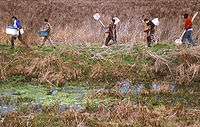
Katy Prairie lies in the Texas Coastal Plain, and encompasses over a thousand square miles, (Wermund, 1994) bound by the Brazos River on the southwest, pine-hardwood forest on the north, and the city of Houston on the east. Historically, Katy Prairie was characterized as a poorly drained tall-grass prairie subject to periodic fires and containing a considerable amount of wetland areas.
Comanche and Karankawa Native Americans were the first humans to use the prairie, following the bison herds which grazed the area. The standing ponds were frequented by thousands of ducks. Up until the end of the 19th century, the prairie remained more or less untouched by Europeans. Around 1870 the first settlers began to raise corn, potatoes, and cattle on the prairie. At the turn of the century, rice farmers appeared, creating 30-acre (120,000 m2) fields harvested by hand.[2] Sportsmen began to take advantage of the hunting opportunities, hunting the indigenous ducks, curlews, and prairie chickens.[3] Small-scale agriculture had only a minor impact on the region, and the prairie remained primarily a plain/prairie ecosystem. In 1914, George Finlay Simmons described the area as still "a coastal prairie region with few farms and ranches; the only timber lies in strips from a quarter to a half mile wide along Buffalo and Bray's Bayous. The remainder of the country is flat, uncultivated prairie, sprinkled with small ponds and grassy marshes".[4]
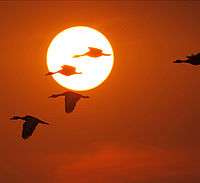
With the escalation of rice farming and population in the 1930s and 1940s came an increase in hunting and birding. Ducks remained the most popular species, but hunted species included snipe, cranes, doves, quail, rails, and geese. The presence of ducks and doves increased, directly due to the habitat availability afforded by the flooded rice fields. However, as farming ate up grassland areas, upland species such as the prairie chicken declined drastically.[3]
Farming advancements during the 1950s and 1960s boosted rice farming to a large scale. It was at this time that the snow goose emerged onto the rairie. Historically, the snow goose wintered in the marshes and prairies along the coast. Vast amounts of available open-water habitat combined with waste rice created by modern farming methods created exceptionally conducive wintering grounds and thousands of geese moved inland to the new habitat.[2] Migratory birds increasingly depend upon this habitat as other areas along the Gulf Coast have diminished in size or lost to development.
Eventually, developers began to appear on the prairie. The city of Houston experienced a huge growth spurt and began spreading to the west and northwest. From 1978 to 1983, 100,000 acres (400 km2) of the prairie were converted to urban use, primarily residential, with some industrial and retail. This was coupled with a decline in rice farming, with land use for rice falling 59% in Waller County from 1980-1992.[5]
Urbanization will have consequences for the future of the prairie, as agricultural use has been consistent with its role as a wildlife habitat for nearly one hundred years. Rice farms in particular provide the wetlands necessary for migratory waterfowl to thrive, while pastures and other croplands provide essential food and cover. Encroaching development puts this function at risk.
The Conservancy
Missions and Goals
The mission of Katy Prairie Conservancy is to preserve, protect, and enhance critical and sustainable portions of the Katy Prairie ecosystem, through -
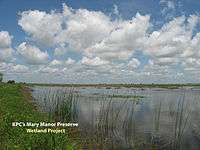
- Protecting between 30,000 acres (120 km2) and 60,000 acres (240 km2) of Katy Prairie, primarily in its current agricultural state, and with some appropriate portions enhanced as wetlands and restored prairie habitat.
- Involving the local community and all stakeholders in the Katy Prairie Conservancy, including hunters, conservationists, landowners, local residents, farmers and developers.
- Responsible stewardship of protected land.
- Conducting and facilitating research needed for the accomplishment of the mission.
- Promoting ecotourism and other economic incentives for conservation on the prairie.
- Educating the public about the prairie.
Human communities are bound in subtle but profound ways to the land. United States history is tied in fundamental ways to the land the people have used, inhabited, developed, and all too often destroyed. Preserving Katy Prairie constitutes an act of faith in the community, the future, and ultimately, in everyone as caring and thoughtful stewards of nature.
Conservancy and how it works
Katy Prairie Conservancy plans to accomplish its goals through use of established land trust strategies. They do not advocate political positions to achieve those objectives. Tools currently used to protect land on the prairie include:
- Acquisition - Outright acquisition of targeted habitats through purchases, bargain sale arrangements, and land donations.
- Conservation Easements - Agreements with private landowners to permanently protect their land's conservation values through the creation of limits on development.
- Management Agreements - Working with cooperating landowners to develop and implement wildlife management plans for their property.
- Mitigation - Acceptance of ownership and stewardship responsibilities for wetland mitigation projects completed by developers who are complying with Clean Water Act wetlands regulations. These wetland creation or enhancement projects are implemented under criteria developed by the conservancy, and are conveyed to the conservancy at the end of the developer's maintenance and monitoring period.
- Seedbank Project - Participation in the Houston Area Seed Bank Project, assisting in the creation, restoration and enhancement of native tallgrass prairie communities.
- Habitat Enhancement - Development and implementation of habitat management projects on conservancy owned or managed lands, to benefit game species, non-game species, and/or species of special concern.
The importance of Katy Prairie Conservancy
Katy Prairie comprises a variety of habitats, including agricultural wetlands, depressional wetlands, creek corridors, and coastal grasslands.
Grassland
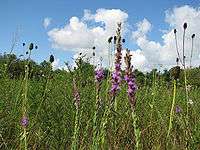
Grasslands are characterized by grasses with extensive root systems, usually with many other herbaceous plants. The domination of grasses is facilitated by periodic drought, grazing, and wildfire (Chadwick, 1995). Coastal prairies in Texas and Louisiana extend 50 to 130 km (30 to 80 mi) inland from the marshes along the Gulf of Mexico. They are nearly level, with elevations from sea level to 75 m (250 ft).[6]
The coastal prairies of the Texas coast once covered about 65,000 km² (13 million acres) from Kennedy County north to the Louisiana border. Today, however, it is estimated that under 65,000 acres (260 km2) remain[7] mostly under private ownership. The remaining grasslands are facing human and agricultural pressures with about one-third of the area cultivated for rice, sorghum, corn, and tame pastures.[8] Much of the rest is threatened by aggressive non-native (also called exotic or noxious) invaders, most introduced intentionally by humans. These species, such as the Chinese tallow (Sapium sebiferum), have little value to native wildlife and can out-compete native plant species. The Louisiana Natural Heritage Program's classifies coastal prairie as "critically imperiled"[9] and the Texas Natural Heritage Program's 1993 classification of the little bluestem and brownseed Paspalum community as "imperiled" and the grama grass and switchgrass community as "critically imperiled." Some of the individual grass species and other rare plants with which they are associated are in danger of becoming extinct, such as Texas windmill grass (Chloris texensis).
Grasslands provide habitat for a wide variety of dependent wildlife, including many migratory birds and endangered species such as Attwater's prairie chicken, which formerly inhabited Katy Prairie. Prairies may be an important sink of carbon dioxide, which is of growing importance in light of concern over global climate changes. Prairies have produced the richest soils for agriculture in the world. They can be hayed, and they provide forage for livestock. Because no fertilizer is required and water is not as critical, the expense of managing native forage is much less than "improved" grass species.[10] This invaluable natural resource has enabled the United States to become the "breadbasket of the world." As a result of continuing habitat loss, prairies have become perhaps the most threatened habitat in the United States.
Wetland
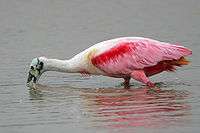
In addition to its extensive grasslands, Katy Prairie also provides extensive wetland habitat. Wetlands are subject to periodic/constant inundation of water which saturates the soil and supports vegetation which can tolerate these soils. Over the course of the history of the United States, more than 115 million acres (470,000 km2) of wetlands have disappeared, down from an original total of 221 million acres (890,000 km2). Over 30 million acres (120,000 km2) of the remaining area are considered too contaminated to be ecologically usable. In Texas, 600,000 acres (2,400 km2) of coastal wetlands and 52% of the total wetland land has been lost, with ongoing loss of prairie wetlands and coastal marshes.[11]
Wetlands like those found on Katy Prairie support a significant amount of industry. Coastal wetlands in the United States provide spawning habitat for 96% of commercial seafood and fishing grounds for about half the recreational users. They support the fur farming industry with $400 million annually. Texas marshlands have yielded up to 500,000 muskrat pelts a year alone. Hunters spend over $300 million to hunt wetland waterfowl.[12] Wetlands are vital for the live bait and birdwatching industries. Annually, over 60 million people observe and photograph wildlife directly supported by wetlands. Wetlands also serve as food and water source for livestock. In the water cycle, wetlands are crucial in restoring ground-water levels, by collecting run-off and precipitation and allowing it to infiltrate slowly into the soil due to the slow water flow rates. This characteristic of water collection also serves to buffer floods, reducing storm surges and river flows.[11] Wetlands are vital as dilution areas for toxic discharges.
Human and wildlife

The diversity of habitats on Katy Prairie allows the co-existence of a variety of people and wildlife. Open spaces like this are crucial to maintaining the freedom and quality of rural life, supporting outdoor activities such as hunting and birding. The prairie supports a large amount of wildlife. An average total of 597,000 representatives of 196 different bird species were recorded in the 1977-1994 period during Christmas bird counts.
The Texas coastal prairie/marsh ecosystem originally supported large populations of alligators, bullfrogs, white-tailed deer, American bison, pronghorn, American black bear, eastern wild turkey, red wolf, eastern gray squirrel, fox squirrel, and muskrat.[13] Currently, beaver, alligator, deer, coyote, bobcat and squirrels still reside on the prairie. Katy Prairie is irreplaceable. It represents a unique resource which will continue to enhance the quality of life for the region's residents for years to come.
Katy Prairie Conservancy Preserves
Nelson Farms Preserve
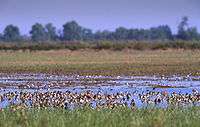
Originally, Nelson Farms Preserve was part of the 1220 Farms property, one of many historic farms and ranches on the prairie. The Nelson family utilized the property for the production of rice, soybeans, cattle and crayfish. Historically, these agricultural wetlands provided critical winter foraging and roosting areas for a number of species of wetland-dependent wildlife, particularly birds. Today, Nelson Farms Preserve encompasses more than 1,700 acres (6.9 km2) and still operates as a working rice farm to benefit wildlife dependent upon the agricultural wetlands present on the landscape. Cypress Creek flows through the preserve offering excellent habitat because of its perennial source of water and vegetative diversity. The unique combination of habitat types attracts significant numbers of waterfowl, waterbirds, migratory songbirds, raptor, beaver, white-tailed deer and other wildlife.
Warren Ranch
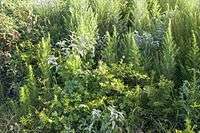
Warren Ranch is one of the largest remaining working cattle ranches on the prairie. It abounds with wildlife and native plants and grasses. There are large concentrations of bushy bluestem, little bluestem, switchgrass, and indiangrass as well as patches of more unusual species to the Houston area such as mesquite and yucca. Rare neotropical migrant birds such as Swainson's warblers use habitat along Cypress Creek at the ranch’s southern end, while at the northern end Warren Lake serves as a major resting and roosting area for many species of duck, including blue and green-winged teal, American wigeon, bufflehead, and ruddy duck, as well as for snow goose, Canada goose, Ross's goose and bald eagle. Wood storks visit the lake in the summer and flocks of American white pelicans can be seen there in the winter. The open country also harbors hawks, bobwhite quail, songbirds, jackrabbits, and deer.
Williams Prairie Preserve
Williams Prairie is a 10-acre (40,000 m2) remnant prairie full of little bluestem, brownseed Paspalum, and Indiangrass. It was utilized historically as a hay meadow, which allowed it to survive in its relatively pristine state. Volunteers have identified 59 species of grass on the property. The prairie is composed of mainly upland prairie with few shallow depressional wetlands that provide habitat for many species of butterfly, birds, and small animals. These two habitats work in conjunction to create the necessary diversity of species needed to maintain a productive native prairie seed bank. Egrets and other herons can be found residing year-round in the depressions as long as they continue to hold water during the warmer months. The same can be said for Ibises and Spoonbills who are frequently seen probing and sifting out invertebrates such as worms and Crayfish from below the water’s surface. Stilts and various Rails, Moorhens, and Coots can also be found in the shallow ponds and depressions.
References
- ↑ "Our Mission". Katy Prairie Conservancy. Retrieved 2008-11-06.
- 1 2 Lobpries, David (29–30 April 1994). "Waterfowl on the Katy Prairie (Utilization & Trends)". Katy Prairie Conference 1994. Katy Prairie Conservancy. p. 1.
- 1 2 Gore, Larry (29–30 April 1994). "The Katy Prairie: Hunting -- Its History and Economic Benefits". Katy Prairie Conference 1994. Katy Prairie Conservancy. p. 2.
- ↑ Eubanks, Ted (29–30 April 1994). "A History and Characterization of the Katy Prairie". Katy Prairie Conference 1994. Katy Prairie Conservancy. p. 1.
- ↑ Henry, Mary Lou (29–30 April 1994). "Growth Patterns of Houston and the Katy Prairie". Katy Prairie Conference 1994. Katy Prairie Conservancy. p. 2.
- ↑ Hatch, Stephan; Gandhi, Kancheepuram; Brown, Larry (1990). "A Checklist of the Vascular Plants of Texas". Department of Rangeland Ecology and Management, Texas A&M University. p. 158. Retrieved 2008-11-06.
- ↑ "Coastal Prairie". United States Fish and Wildlife Service. Retrieved 2008-11-06.
- ↑ Wagner, Matt; Riskind, David (1992). "Coastal prairie restoration on state parks". 27th Annual Meeting. Austin, Texas: Texas Chapter of The Wildlife Society. p. 6. Retrieved 2008-11-06.
- ↑ Smith, Latimore (August 1996). "The Rare and sensitive natural wetland plant communities of interior Louisiana" (PDF). Baton Rouge, Louisiana: Louisiana National Heritage Program Louisiana Department of Wildlife & Fisheries. Archived from the original (PDF) on May 27, 2010. Retrieved 2008-11-06.
- ↑ Campbell, J.A. (24 October 1996). "Native Gulf coast prairie restoration project". The Coastal Prairie and Native Grasses Symposium. Houston Texas: United States Geological Survey.
- 1 2 Tacha, Thomas (29–30 April 1994). "Wetland Functions and Values in a Prairie Environment". Katy Prairie Conference 1994. Katy Prairie Conservancy. p. 4.
- ↑ Tacha, Thomas (29–30 April 1994). "Wetland Functions and Values in a Prairie Environment". Katy Prairie Conference 1994. Katy Prairie Conservancy. p. 3.
- ↑ Stutzenbaker, Charles (29–30 April 1994). "A Case History of the Peacemeal Degradation of the Texas Coastal Prairie and Marsh Ecosystem". Katy Prairie Conference 1994. Katy Prairie Conservancy. p. 9.
| Wikimedia Commons has media related to Katy Prairie Conservancy. |
Further reading
- Bohnen, Julia; Hanchek, Ann (6–9 August 1992). "Native grass and wildflower seed: an LCMR grant". Proceedings of the Thirteenth North American Prairie Conference. Windsor, Ontario Canada: Windsor Department of Parks and Recreation. pp. 239–241.
- Cameron, G (24 October 1996). "Impact of exotic species on biodiversity of coastal prairie". The Coastal Prairie and Native Grasses Symposium. Houston Texas: United States Geological Survey.
- Chadwick, D (1995). "What good is a prairie?". Audubon. National Audubon Society. 97 (6): 36–46, 114–117.
- Honing, Robert; Wieland, Gregory (22–26 February 1997). "The Houston Region Native Grass Seedbank: a natural partnership between right-of-way management and conservation". The Sixth International Symposium on Environmental Concerns in Rights-of-Way Management. New Orleans, Louisiana: Elsevier Science Ltd.
- McFarlane, Robert (29–30 April 1994). "Birdlife on the Katy Prairie". Katy Prairie Conference 1994. Katy Prairie Conservancy. p. 8.
- Wermund, E.G. (29–30 April 1994). "Geology and Physical Features of the Katy Prairie". Katy Prairie Conference 1994. Katy Prairie Conservancy. p. 1.
- Texas Mid-Coast Initiative Team (1990). Texas Mid-Coast Initiative: Gulf Coast Joint Venture, North American Waterfowl Management Plan. Albuquerque, New Mexico: United States Fish and Wildlife Service. p. 27.
- "Plant communities of Texas, series level". Texas Natural Heritage Program. Austin, Texas: Texas Parks and Wildlife Department. 97 (6): 26. 1993.
